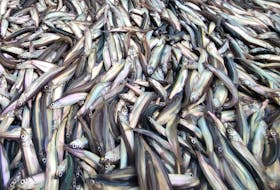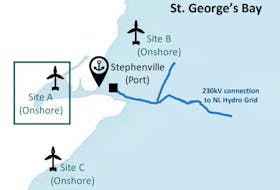On March 12, DFO dropped a bombshell at its technical briefing on the status of Atlantic salmon stocks in Newfoundland and Labrador.
The briefing, to conservation groups and the media, provides counts compared to previous years of salmon returns in 17 monitored rivers. These counts are used to calculate the extent to which the river’s conservation target is being met. Stakeholders then provide advice to DFO for preparation of the salmon management plan. I attend such presentations on behalf of the Salmonid Council of Newfoundland and Labrador.
This year’s presentation was dramatically different, because DFO raised an alarm by stating that salmon populations in the Conne and Little rivers on the south coast were near local extinction. They went on to say that the word “extinction” was chosen carefully. DFO emphasized that just 157 salmon returned to Conne River, down over 95 per cent from returns of 10,000 in the 1980s. DFO identified potential reasons for the decline and pointed out that aquaculture in the immediate area of these rivers is one of those factors. Open-net pen aquaculture has been practiced here for about 35 years, coinciding exactly with the period of decline.
DFO emphasized that just 157 salmon returned to Conne River, down over 95 per cent from returns of 10,000 in the 1980s.
To put things in perspective, other factors affecting the marine survival of salmon apply to all the monitored rivers, but the south coast rivers also bear the brunt of aquaculture impacts.
For example, DFO scientists studied interbreeding between escaped farm salmon and wild salmon in 18 south coast rivers and found widespread interbreeding in 17 of them, in some cases as high as 30 per cent. This weakens the gene pool for wild salmon because the progeny of farmed salmon are not genetically equipped to survive in the wild. This research has been peer reviewed and published and is easily found by a literature search. It is a matter of fact, not opinion. However, the aquaculture industry denies having any negative impact on wild salmon.
The effects of sea lice are even worse. Sea lice are present naturally in the marine environment but thrive in the densely stocked farms that are located near the mouths of salmon rivers. Salmon smolt that are beginning their first migration to sea have to swim by these cages and are even attracted to them. It takes about 10 sea lice to kill a smolt. Salmon farmers are well aware of the deadly effect of sea lice and routinely treat their salmon with chemical pesticides to reduce the sea lice. There is no such help for wild smolt which never make it to the open ocean and never return to the river to spawn.
Like interbreeding, the impact of sea lice on wild salmon has been studied and documented in Norway and elsewhere, but unfortunately not in Newfoundland and Labrador. DFO needs to address this knowledge gap as there is no likelihood that the industry will admit responsibility. Ironically, the Government of Canada, through the North Atlantic Salmon Conservation Organization (NASCO), has committed to zero escapes and zero impacts from sea lice but has failed to deliver.
Other aquaculture impacts come from the infectious salmon anemia (ISA) virus, which has been damaging to the Newfoundland and Labrador aquaculture industry. Deaths from ISA and other causes meant that the overall mortality rate for 2019 was 54 per cent; in 2020 it was over 40 per cent. These numbers come from the provincial government in response to a freedom of information request and are easily confirmed. Antibiotics and quarantines are routine but do not protect wild salmon and other species which are also affected by these highly contagious pathogens.
The saddest part of this letter is that the provincial government is poised to expand open-net pen aquaculture east into Placentia Bay with the massive 33,000-metric tonne Grieg project, consisting of 11 farms, many located close to wild Atlantic salmon rivers. Mowi, another Norwegian aquaculture giant, is expanding to the west.
All this just as the rest of the aquaculture world is moving to land-based salmon farming. Down the road, DFO will be warning about the extinction of wild Atlantic salmon populations in all our south coast rivers.
Leo White, president
Salmonid Council of Newfoundland and Labrador









